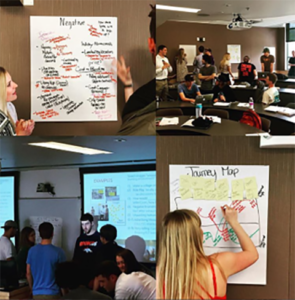Empathy helps create valuable solutions in the marketplace, and it’s a fundamental principle within Design Thinking, according to Dr. Chris Blocker.
 The Design Thinking approach to product design shines when it comes to uncovering latent needs — desires that people have but have a harder time trying to articulate. Furthermore, as Blocker says, “Design Thinking adopts an interdisciplinary perspective. It works best when you have diverse people from different fields, perspectives, and training — all working together.”
The Design Thinking approach to product design shines when it comes to uncovering latent needs — desires that people have but have a harder time trying to articulate. Furthermore, as Blocker says, “Design Thinking adopts an interdisciplinary perspective. It works best when you have diverse people from different fields, perspectives, and training — all working together.”
Training Students to Think in Differently
To that end, Blocker and CSU Engineering instructor Olivera Notaros began bringing their students together about two years ago to think through the challenges of bringing new technologies to market. “These senior engineering design students have so much know-how and skill for making new technologies work,” says Blocker. “So, it is a wonderful opportunity to have our marketing students complement their projects and help engineering students think about business models, customer needs, market segments, and ways to create value for customers.”
Notaros and Blocker have taken it upon themselves to facilitate this collaboration on an ongoing basis within the product development class (MKT 364). Before the semester, they choose 4-5 senior engineering design groups that they believe are “ripe for design thinking and marketing ideas,” Blocker says. “Then, in our class, we run a Design Thinking style workshop, to ideate around the engineering idea.”
 In the workshop, the engineering team members first present an overview of the technology they are working on. Then, the marketing students have the chance to join the conversation. Students work together across creative, Design Thinking style exercises to explore possible applications, target audiences and personas, market segments, and value propositions.
In the workshop, the engineering team members first present an overview of the technology they are working on. Then, the marketing students have the chance to join the conversation. Students work together across creative, Design Thinking style exercises to explore possible applications, target audiences and personas, market segments, and value propositions.
Creating Value for Diverse Groups
For Blocker, Design Thinking is as much a way of solving everyday problems as it is a method for designing solutions for the market. His research on value creation in a variety of contexts has explored solutions both for large enterprises as well as with individuals and entrepreneurs living in impoverished conditions.
“Human-centered design is a perfect approach for situations where traditional, Western top-down marketing doesn’t work,” he says. To date, he’s researched and worked on many projects geared toward creating customer value both within developing markets as well as vulnerable populations (e.g., homeless) within developed markets.
Gaining Skills for Future Careers
In a similar vein, marketing and engineering students that collaboratively practice Design Thinking gain opportunities to not only positively shape live projects but also shape their career paths while thinking about projects that can produce a societal impact.
Blocker notes that the students are learning how to work with others who view the world differently, and who speak a different (professional) language. This skill can be invaluable when they enter the workplace and find themselves interacting with individuals across an organization who have very different perspectives.
Student feedback so far has been extremely positive, and Blocker says there is now some discussion around opportunities to create a more formalized collaboration within the curriculum. In the meantime, he is pleased with the effects that have been evident thus far. Students are highly engaged while learning to be more thoughtful and more empathetic toward their future “customers.”